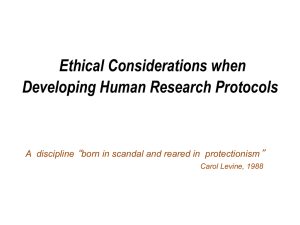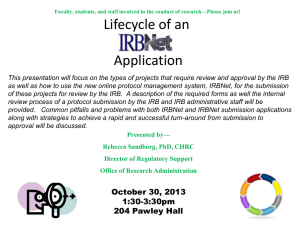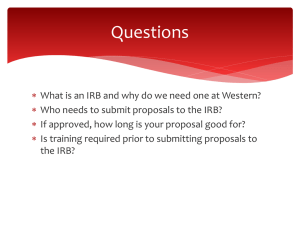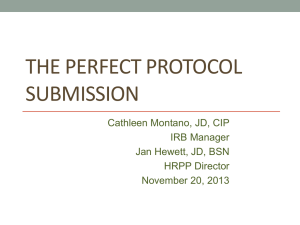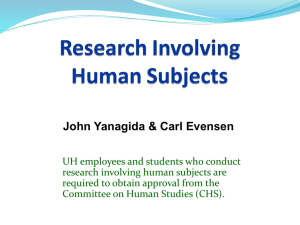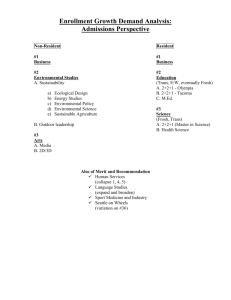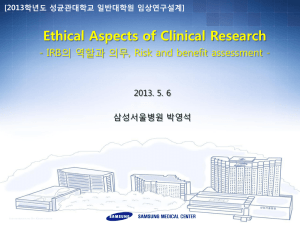Slide presentation: HSR at Evergreen
advertisement
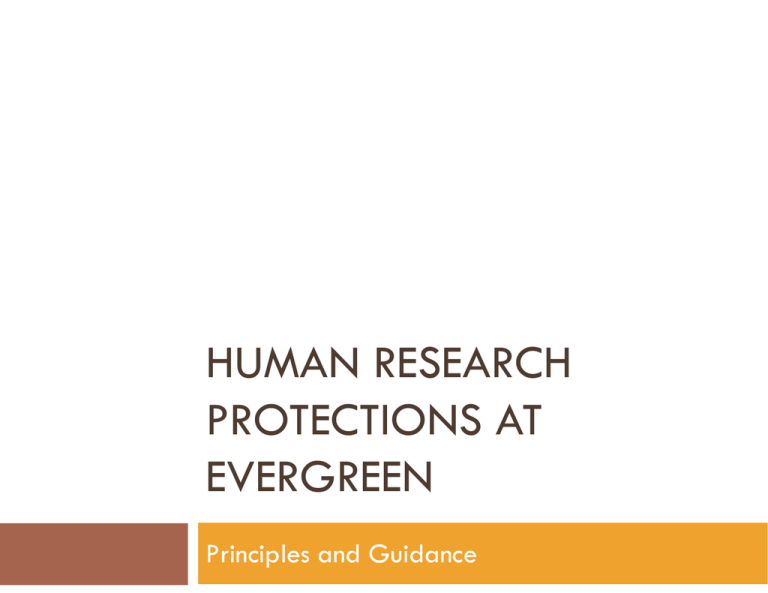
HUMAN RESEARCH PROTECTIONS AT EVERGREEN Principles and Guidance Human Subjects Review The Evergreen State College • • • • • • • Historical overview Codes and principles Categories of research Review criteria Application processing procedures Online resources and references Q&A John McLain, April 2014 Nazi Germany Medical Experiments 1933-1945 Nazi doctors and scientists conducted cruel, harmful, often lethal experiments on prisoners in war camps Nazi Physicians at Auschwitz camp, between 1941 and 1944 -- Source: United States Holocaust Memorial Museum Nuremberg Trials 1946 • 16 of 23 defendant physicians convicted, 7 sentenced to death for “crimes against humanity” • “Permissible Medical Experiments” used as standards for judgment, became known as the “Nuremberg Code” (1948) Nuremberg, Germany, 1946 -- Source: United States Holocaust Memorial Museum Thalidomide Europe, Canada, US - late 1950s Pregnant women given thalidomide, an experimental drug prescribed to control nausea • Expectant mothers not informed of related risks or that the drug was experimental • Did not consent to participate in research • Thalidomide caused severe birth defects in fetuses, resulting in 12,000 deformed and limbless infants • Controversial Social Science Studies • Wichita Jury Study - 1955 Recorded deliberations of juries without disclosure • Threatened “sanctity” of the jury system • • Tearoom Trade Study - 1960s Laud Humphreys studied subjects who engaged in clandestine homosexual behavior and without their knowledge • Deceived subjects in follow-up research • Some subjects inadvertently identified in reports • • Stanley Milgram studies of obedience to authority - 1960s Deceived subjects, who were instructed to inflict pain on others • Created psychological trauma • Tuskegee Syphilis Study U.S. government syphilis experiments - 1932-1973 • • • • • 600 African-American male subjects Unaware of infection, not informed of being involved in research Exposed to risky medical procedures for research purposes, but without therapeutic value Not given penicillin long after it became standard, effective treatment 28 subjects died; hundreds experienced extreme disabilities; wives were infected; 19 documented cases of congenital syphilis Tuskegee Outcomes • • • • U.S. Congress commissions a Syphilis Ad Hoc Study panel in 1973 to investigate Tuskegee study Immediately stops study and recommends federal regulation of human subjects research Compensates subjects for medical expenses to the time of their death, though treatment is palliative; it is too late for effective reversal of disease Provides edical treatment for subjects, infected spouses and children New legislation governing human subjects research Milestones in Human Subjects Protections • 1948 - Nuremberg Code Establishes principle of voluntary, informed consent • Research on humans should have a favorable risk/benefit analysis • Right to withdraw without penalty • • 1962 - Kefauver-Harris Bill Ensures greater drug testing safety • Along with Nuremberg Code, establishes that research participants be fully informed of potential risks or harm that may result from taking part in a study • • 1964 - World Medical Association, Declaration of Helsinki: Interests of the subject should always be given higher priority than those of society • Every subject in clinical treatment should get the best known treatment • Code continues to be revised • U.S. Human Subjects Review Law • 1974 – National Research Act establishes current Institutional Review Board (IRB) process and national commission for protection of human subjects • 1978 • 1991 – Common Rule established in the – National Commission (Belmont) Report establishes principles governing human subjects research in U.S. code of the Department of Health and Human Services (Title 45 Code of Federal Regulations [CFR] 46, Subpart A) U.S. Human Subjects Review Law The federal code and revisions establish protections, including special provisions for pregnant women and individuals with diminished autonomy, e.g., children, fetuses, prisoners • All recipients of federal research funds must submit to IRB review and approval for research about or directly involving human subjects, and have appropriate procedures to protect subjects from undue or unnecessary risks, and to protect their privacy and assure confidentiality • Regardless of funding sources, most institutions use an IRB process to protect human subjects • National Commission (Belmont) Report - 1978 Eight-page document, establishes three principles for human subjects protection: I. Respect for Persons II. Beneficence III. Justice I. Respect for Persons • • Treat individuals as autonomous agents Protect persons with diminished autonomy Requirements for IRB approval: Voluntary and informed consent process Protection of privacy and confidentiality II. Beneficence • Maximize potential benefits and minimize potential risks Requirements for IRB approval: Risks justified by potential benefits Study design minimizes risks Conflicts of interest are managed adequately III. Justice • Distribute risks and potential benefits equally among those who may benefit from research Requirements for IRB approval: Vulnerable subjects not targeted for convenience People likely to benefit not systematically excluded What is an IRB? A board of individuals charged with protecting the rights and welfare of human subjects of research • IRBs review and approve research plans • IRB membership is representative of disciplines and backgrounds at the institution • A project must both be research and involve human subjects to require IRB review Research Defined Research means a systematic investigation, including research development, testing and evaluation, designed to develop or contribute to generalizable knowledge. (45 CFR §46.102; underlining added) Human Subject Defined Human subject means a living individual about whom an investigator (whether professional or student) conducting research obtains: (1) Data through intervention or interaction with the individual, or (2) Identifiable private information. (45 CFR §46.102; underlining added) Projects Often Not Considered Human Subjects Research • • • • • Journalism Art projects Informational interviews Oral histories Case studies See www.evergreen.edu/humansubjectsreview/nonhsr.htm. And when in doubt, ask! Categories of HSR Applications • Exempt – minimal risk activities defined in law and includes educational evaluations, work with public officials, anonymous surveys, and others (see 45 CFR Part 46.101(b)); exemptions must be approved by IRB administrator at Evergreen • Expedited – minimal risks to subjects or minor changes to board reviewed projects • Board Reviewed – any project that presents more than minimal risk to subjects or that works with certain protected populations (e.g., prisoners) HSR Review Criteria and Issues • Complete Application • • • • Answers to the six questions Informational cover letter (or script, if appropriate) Consent agreement form (or script, if appropriate) Copies of advertisements, emails, letters, etc., used to recruit participants Content should be consistent between all documents. In answer to the six questions: 1. Summarize your project in an abstract 2. Explain the procedures to which humans will be subjected 3. Describe how participants will be recruited 4. Describe the possible risks to subjects, and how you will mitigate those risks 5. Describe the benefits to be gained by the study 6. Describe how the information to be gained by this study will be used and who potentially will see it 1. Abstract • Summarize your study • • What do you hope to find out? How will you find it out? 2. Procedures • • • Describe exactly what interactions you will have with participants and what procedures they will undergo Be detailed: surveys, interviews, photography, recordings, blood draws, physical examinations, etc. Include time estimates for interaction, follow-up interactions, research settings, etc. 3. Recruitment • • • • What type of participants are you looking for (age, race, gender, employment, affiliation, health status, etc.)? What methods will you use to recruit participants (On-the-street, email contacts, social media, existing contact lists, etc.)? What are your sampling procedures (random, snowball, etc.) Does your recruitment require cooperation from another organization? Do you have written approval? 4. Risks • Describe the risks to participants of your study – and not only physical risks Emotional • Social • Economic • Civil/criminal liability • • • • “None” is not a good answer No more than minimal risk means no risks greater than those encountered in daily life Outline plans for mitigating risks through protection of private information, plans to provide personal and emotional safety, follow up referrals, etc. 5. Benefits • • • What may be learned that makes the participation of human subjects worthwhile Benefits may be individual, institutional or societal Provide a good reason for putting your subjects through the procedures you propose -- i.e., How does the benefit outweigh the risk? 6. Use of Information • Disclose how information will be disseminated, to whom … In publications • On the web • With other individuals or organizations • • How will you maintain promised confidentiality or ensure anonymity? Achieving INFORMED Consent Your subjects need to know: • Your purpose and research procedures • Risks and discomforts for them • Your plans to eliminate risks and discomfort • Provisions for confidentiality • That their participation is truly voluntary, at all points in the research • Contact information for the researcher and the human subjects review administrator at the college Informed consent is a process, not an event. Core Design Considerations • Have a good research model designed to get reliable outcomes • • If you don’t have a reasonable chance of getting good outcomes, you shouldn’t put human beings through the trouble A study is ethical or not at the outset • The findings of a study will not make it ethical; ends do not justify means Curiosity is Not “Need to Know” Special Considerations • • • • • Agreements from cooperating institutions (schools, employers, tribal governments, etc.) Vulnerable populations (children, prisoners, et al.) Online surveys and consent Anonymity vs. confidentiality Identity is more than just a name HSR Process at Evergreen • • • • Submit hard copy application to Academic Deans Office in Library 2002 Initial reviews take up to two weeks Resubmissions and re-reviews may also take up to two weeks Must not start research until approval received Online Resources www.evergreen.edu/policies/policy/useofhumansubjects (link to Evergreen HSR Policy) www.evergreen.edu/humansubjectsreview/ (link to Evergreen HSR information and application) www.hhs.gov/ohrp/humansubjects/guidance/45cfr46.htm (link to federal regulations) www.hhs.gov/ohrp/irb/irb_guidebook.htm (link to HHS IRB Guidebook) Contact John McLain Academic Grants Manager and IRB Administrator mclainj@evergreen.edu 360.867.6045 Jules Raney Program Assistant raneyj@evergreen.edu 360.867.6810

